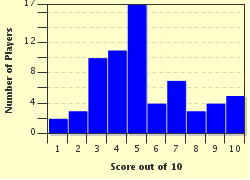Quiz Answer Key and Fun Facts
1. In international politics population transfers used to be considered a suitable way of resolving what particular issue?
2. What made population transfers more 'practical' from the mid-19th century?
3. The Cromwellian conquest of Ireland between 1649 and 1653 led to the deportation of around 50,000 Irish Catholics. Where did they go?
4. Which Norwegian Arctic explorer-turned diplomat was the facilitator of the 1923 Greek-Turkish population exchange involving some two million people?
5. What was the trigger for the massive population exchanges between India and Pakistan in 1947?
6. The Inca Empire carried out population transfers into the 16th century, causing problems for the conquistadors. Why were the population transfers done?
7. Forced migration can be as a result of economic development. The construction of the Three Gorges Dam on the Yangtze River in China was an example where over 1.2 million people were moved. Apart from generating electricity, what other important benefit did this dam provide?
8. Which Ukrainian city's population of about 50,000 were forced to abandon their homes in 1986?
9. The Soviet Union employed population transfer for many reasons and often at great human cost. One such occasion was the forceful repatriation of Soviet citizens back into the Soviet Union at the end of the Second World War. How was this achieved?
10. Midnight Oil's song and the title of this quiz: for what reason was the Pintupi people moved from an area of the Western Desert region to the Northern Territory in Australia from the 1940s?
Source: Author
suomy
This quiz was reviewed by FunTrivia editor
gtho4 before going online.
Any errors found in FunTrivia content are routinely corrected through our feedback system.

